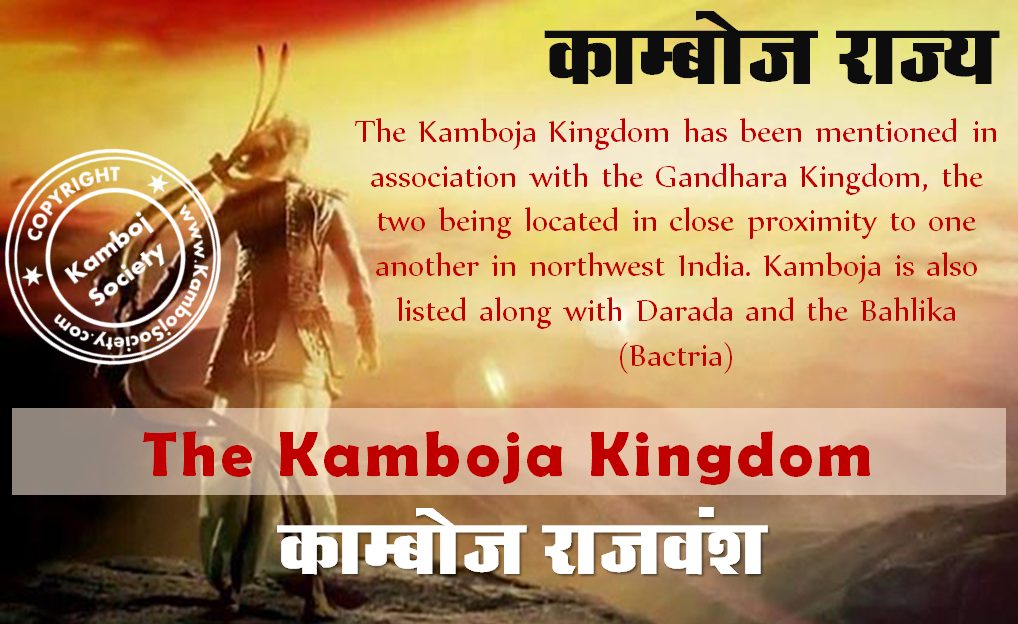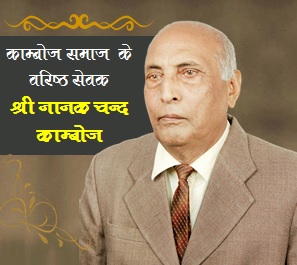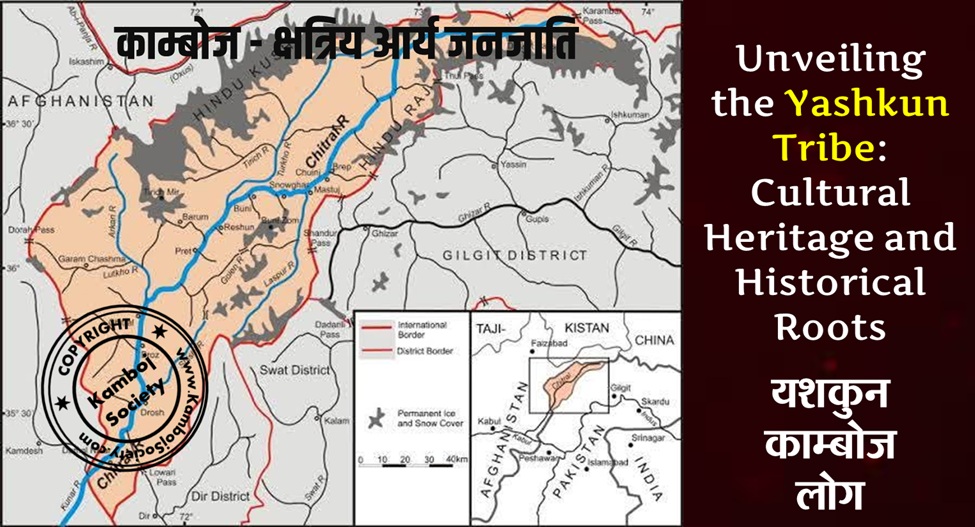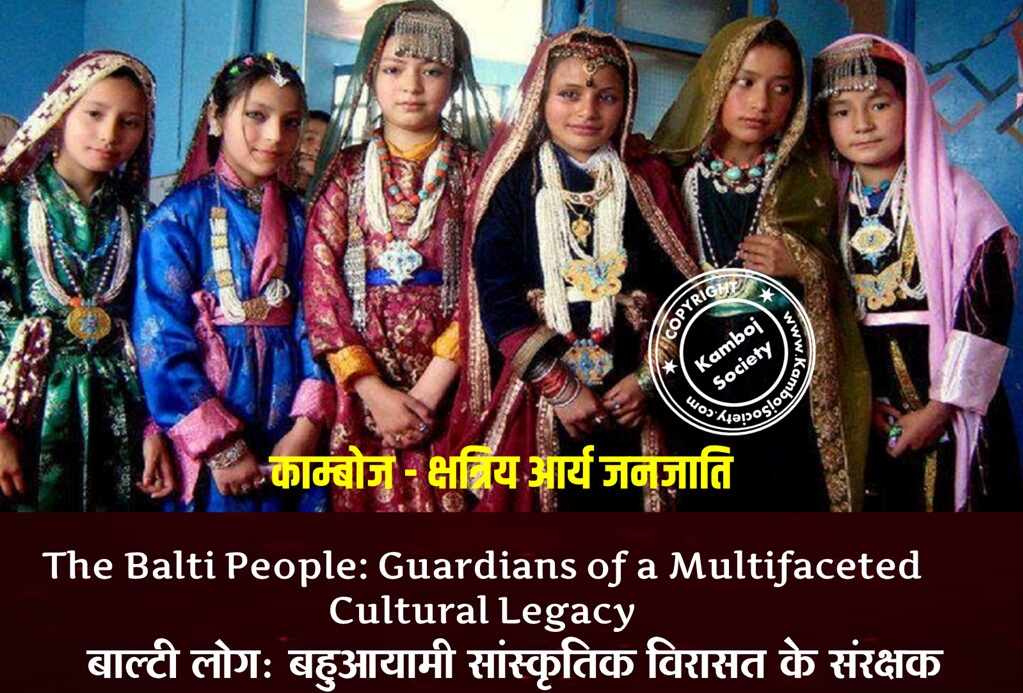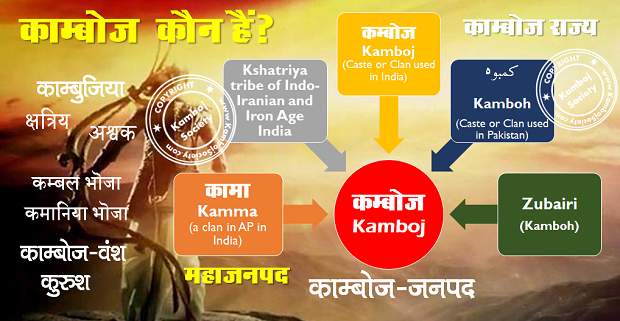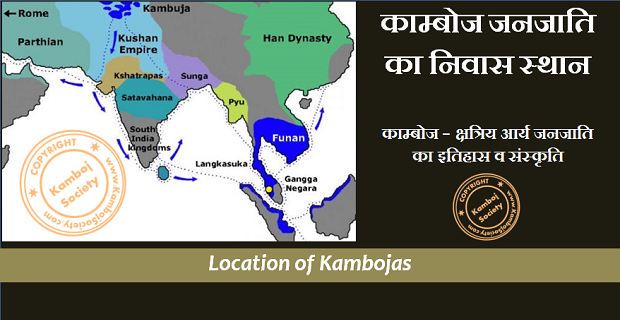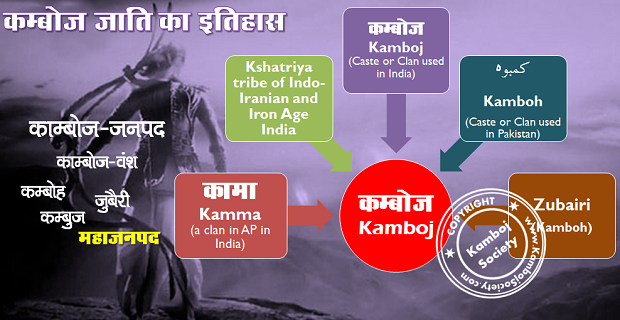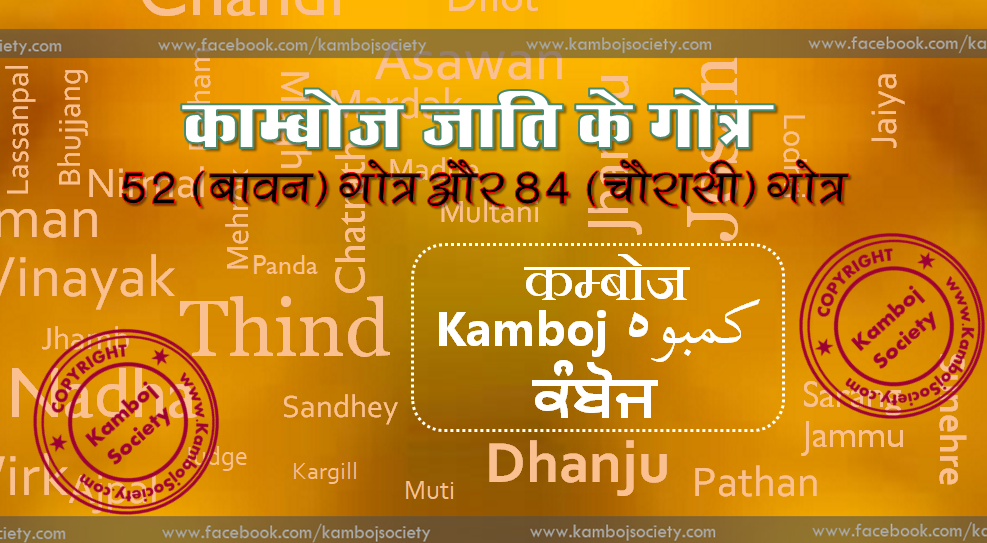This article is about the kingdom of Kamboja in Indian epic literature. For the historical kingdom, see Kamboja. For the people, see Kambojas.
Kamboja or Kamvoja is a kingdom grouped among the western kingdoms in the epic Mahabharata. Western kingdoms were cold countries and people used blankets. They also reared sheep and drank sheep milk. Kamboja Horses were of excellent quality. Their horses and even horsemen were used in the wars between kings of Aryavarta (North Indian kingdoms where Vedic culture of the norm, prevailed). Their soldiers used to aid both the parties engaged in a battle on a payment basis. In the Kurukshetra War, there were Kamboja soldiers on both Pandava side and Kaurava side.
In the epic Mahabharata, Kamboja is sometimes referred to as a republic or a kingless country where elected chiefs among the people ruled the country. A kingless country is othervise called Arashtra or Aratta. This name is sometimes collectively used to denote many other western kingdoms like Madra Kingdom|Madra, Kekeya Kingdom|Kekeya and Gandhara Kingdom|Gandhara. Another collective name denoting the western kingdoms is Bahika ( Vahika, Vahlika, Bahlika Kingdom|Bahlika or Vahika) meaning outsider. This is to denote that their culture was outside or different from the Vedic culture, prevailed in the Kuru Kingdom|Kuru, Panchala Kingdom|Panchala and other kingdoms of the Gangatic plain. The Kamboja country closest to Aryavarta was the one with Rajapura as its capital, which is identified as Rajauri of Kashmir. Other than this country, the epic mentions about a Kamboja close to Darada Kingdom, an eastern Kamboja and a Parama Kamboja country in the far north, all famous for excellent breeds of horses. Another country Aswaka (the horse country) also is related to Kamboja, being either a province of Parama Kamboja or a neighbouring country. Some historians believes that Afganistan is a name derived from the name Aswaka Stana meaning, the land of horses.
A clan of tribess called Kinnara Kingdom|Kinnaras were believed to be the Kamboja horse warriors. Kinnaras were described to be horse-headed humans. This could be an exaggeration of their extra ordinary skill in cavelry warfare. In Kali Yuga, Kambojas had many colonial states in central India, inculding the Asmaka Kingdom|Asmaka or Aswaka of Maharashtra state. Cambodia, a modern country of South East Asia, is another colony of Kambojas during the time of recorded history. The word Kam can mean 'woolen cloth' (Kambala), denoting the dress of the people. Another meaning of the word Kam is 'place' or 'region'. It is surprising to note that there are many places in Asia, Europe and especially around Mount Meru of Tanzania in Africa with the word Kam in it, denoting the meaning place or region, hinting towards the African origin of human beings (homo sapiens).
- Capital: Rajapura (Rajauri, Kashmir)
References in Mahabharata
Among the tribes of the north are the Mlecchas, and the Kruras, the Yavana Kingdom|Yavanas, the China of Mahabharata|Chinas, the Kamboja Kingdom|Kamvojas, the Darunas, and many Mleccha tribes; the Sukritvahas, the Kulatthas, the Huna Kingdom|Hunas, and the Parasikas; the Ramanas, and the Dasamalikas. --- Kamboja mentioned as a kingdom in ancient India (Bharata Varsha). (6,9)The migration of Kambojas
The Yavana, Kamvojas, Gandharas, Kiratas and Barbaras. All of them were characterised by practices alien to the normal culture. In the Krita age they were nowhere on earth. It is from the Treta that they have had their origin and began to multiply. When the terrible period came, joining Treta and the Dwapara, the Kshatriyas, approaching one another, engaged themselves in battle. (12,206).
Absence of Brahmins in Kamboja
It is in consequence of the absence of Brahmanas from among them that the Sakas, the Yavanas, the Kambojas and other Kshatriya tribes have become fallen and degraded into the status of Sudras (13.33.20-21; cf: 13,35.17-18). The Dravidas, the Kalingas, the Pulandas, the Usinaras, the Kolisarpas, the Mahishakas and other Kshatriyas, have, in consequence of the absence of Brahmanas from among their midst, also become degraded into Sudras (MBH 13.33)
The passage gives signs of the cultural differences which prevailed among the Sakas, Yavanas, Kambojas of north-west (Uttarapatha) and the Kalingas, Dravidas, Pulindas etc of Dakshinapatha with the mainstream culture obtaining in the plains of Ganga.Arjuna's conquests
Arjuna encountered two Kamboja kingdoms in the northern region. One is close to the Daradas, and the other one is the eastern Kambojas.
Arjuna defeated the Kasmira Kingdom|Kashmiras, the king Lohita along with ten minor chiefs, the Trigarta Kingdom|Trigartas, the Daravas, the Kokonadas, the delightful town of Avisari, the king Rochamana ruling in Uraga, the town of Singhapura that was well-protected with various weapons, the regions called Suhma and Sumala and the Bahlika Kingdom|Valhikas always difficult of being vanquished. Then, Arjuna taking with him a select force, defeated the Daradas along with the Kambojas. Then the exalted son of Indra vanquished the robber tribes that dwelt in the north-eastern frontier and those also that dwelt in the woods. He also subjugated the allied tribes of the Lohas, the eastern Kambojas (=Parama Kambojas), and northern Rishikas. And the battle with the Rishikas was fierce in the extreme.
Karna's conquests
There are at least four references in the Mahabharata which mention Karna's conquest of the cis-Hindukush Kambojas with their political metropolis at Rajapura (modern Rajauri). This Kamboja kingdom is believed to have included south-west of Kashmir extending west and included Swat and Kunar and Alishang valleys north of river Kabol i.e as far as Kafirstan[1].
In Drona Parava, Bhishma while lying on arrowy bed refers to Karna having proceeded to Rajpura, their capital, and vanquished the Kambojas (7.4.5).
Drona Parava again notes: "...And numerous Ganas (sanghas/republics) of the Kambojas (Kambojana cha ye ganah), regarded as very brave and accomplished warriors in the battle-field (sangrame shura sammatah), and whom Karna had fought with and vanquished in former times, with Bharadwaja's son Ashwathama placed at their head, and becoming regardless of their lives, they rushed towards Arjuna to resist that angry hero " (7.91.39-41)
Dhritarashtra talks of Karna having conquered the Kambojas, the Kekayas, the Avantyas, the Gandharas, the Madra |Madarakas, the Trigartas, the Tanganas, the Shakas, the Panchalas, Videhas, Suhma, Anga, Vanga, Nishadas, Kalingas, Vatsa, Asmaka Kingdom |Ashmakas, Rishikas(i.e south-western Rishikas located in Maharashtra) and numerous others including the mlechchas and forest tribes (8.8.18-20).
Again Dhritarashtra states that Karna had vanquished all the Kambojas, the Amvashthas with the Kekaya |Kaikeyas, the Gandharas and the Videhas and subjugated the whole Earth for the sake of Duryodhana's sake (8.9.33-34).
Shalya also refers to Karna having vanquished the Videhas, the Ambashthas, the Kambojas, the Naga tribes and the Gandharas (8.39.47).
Vasudeva Krishna's conquests
The Daserakas, the Kasmirakas, the Aurasikas, the Pisachas, the Samudgalas, the Kambojas, the Shakas, the Khasas, the Yavanas, the Vatadhanas, the Trigartas, the Malavas, the Daradas were mentioend as conqured by Vasudeva Krishna (7.11.15-18)
Kamboja Kings in Mahabharata
King Kamboja
Shanti Parava of Mahabharata refers to a warrior king whom it calls Kamboja. The name appears in the long list of important monarchs and other celebrated personages of remote antiquity all connected with the tradition of daivi khadga or divine sword referenced in the great epic (See: Mahabharata Sword). It has been pointed out by scholars that this Kamboja prince was the eponymous ancestor of the Kambojas i.e he gave his name to his clan which later became known as Kamboja (See: Kamboja, Puranic Encyclopaedia, by Vettam Mani). There may be reasons to believe that these Kamboja people may have been originally from the Puru/Kuru race.
King Chadravarman Kamboja
Chandravarman Kamboja|Chadravarman is mentioned as a renowned (vikhiyaat) king of Kambojas, linking him with the Daitya clan of Asuras. The prince is referred to as exceedingly hanndsome, like the lord moon among the stars (1.67.31-32).
King Kamatha Kamboja
Kamboja King Kamatha Kamboja|Kamatha is mentioned along with King Kakshasena, king Kshemaka, king Kampana who terrorized the Yavana Kingdom|Yavanas and the king of the Madra Kingdom|Madrakas. All of them are described as saliant Kshatriyas (Kshatriya shreshtha ) and had come to attend the event of Pandava king Yudhisthira's entry to his new palace at Indraprastha. (2.4.22)
King Sudakshina Kamboja
Sudakshina |Sudakshina Kamboja is mentioned to have attended Draupadi's self-choice (Swayamvara) ceremony along with the kings of neighbouring kingdoms viz Shalya, the king of Madra Kingdom, with his son, the heroic Rukmangada, Rukmaratha, Somadatta (king of Bahlika Kingdom) of the Kuru race with his three sons - Bhuri, Bhurisrava, and Sala. He is said to be of Puru's race (1.185.15)--which means he was from Kamboja clan but from Puru race (Sudaksinashcha.Kambojo.drdhadhanvaa.cha.Pauravah). Some recensions of Mahabharata mention Kuru instead of Puru (Sudakshinashcha Kambojo dridhadhanva cha Kauravah). But since Kurus descended from the Puru race, and if Ganguli's translation of Mahabharata is indeed correct, then this implies that both the Kambojas and the Kurus had their ancestors in the Purus, and in remote antiquity, the Kurus, Purus and Kambojas may have had common ancestors from which may have off-shot the Kurus, the Kambojas as well as the Achaemenian ruling family of Persia, which had names of several of its rulers as Kurush, Kambujiya (or Kambaujiya), apparently named after the fabled heros of Mahabharata war. See foot notes:
[2].Sudakshina Kamboja was one among the generals of the Kaurava army in Kurukshetra War (6.16.15-17),(5,155.30-33). The Kaurava generalissimo rated this car-warrior as a Ratha. Bhishma's words:- Sudhakshina, the ruler of the Kamvojas, is in my judgment, equal to a single Ratha. Desiring the success of Duryodhana's object, he will fight. As regards the car-army of this king, those smiters of fierce impetus, the Kamvojas, will cover a large area like a swarm of locusts! (5.166-1-3).
At the start of war, Vasudeva glorifies Sudakshina and lists him amongst the greatest Maharathas gathered at Kurukshetra battlefield (5.95.19-21).
Duryodhana gives a very important place to Sudakshina by placing him side by side with the greatest heroes on his side. He boasts of to Pandavas saying that his immense army has Bhishma as the current which cannot be crossed, Drona as the alligator which cannot be approached, Karna and Salya as a swarm of small fishes and the Kamboja as volcanic mouth giving out flames (5.160.40).
Duryodhana again extols the prowess of Sudakshina, along with Bhishma, Drona Acharya, Kripa Acharya, Kritvarma, Bhurisravas, Vikarna and Bhagadatta--- describing them all as 'Great Maharathas, high born, recklessly fearless, and in might and fight, more than a match even to the three worlds put together (6.65.31-33).
Karna also applauds Sudakshina as a great stalwart and includes him among the greatest generals of Bharata war, stating that Sudakshina and other select warriors were undefeatable even by the gods themselves (7.158.64-66)Sudakshina Kamboja is described as very tall, gaura- varna and extremely handsome (sudarshaniya) young prince (7.82.74). He is stated to be very fierce, brave, intelligent and illustrious warrior in the battlefield.
Prince Prapaksha Kamboja
The fourth prince of the Kambojas referenced in the Mahabharata is the younger brother of Sudakshina. In the epic, this prince is simply addressed as Kamboja, but according to Pandit Bhagavadatta Sharma, his real name was Parpakash Kamboja (Bharata ka Itihaas, p 161). After Sudakshina fell in battlefield on 14th day of Kurukshetra war, the supreme command of Kamboja division went to this younger brother of Sudakshina. Prapaksha also fell a martyr to Kuru cause on 17th day of the war at the hands of Arjuna (8.56.111-114). Like his brother Sudakshina, prince Prapaksha is also described as very tall, of gaura-varna and exceedingly handsome prince with eyes resembling lotus petals[https://www.sacred-texts.com/hin/m08/m08056.htm]Tribute to Yudhisthira
The king of Kambhoja sent unto Yudhisthira as tribute innumerable skins, black, darkish, and red, of the deer Kadali, as also numberless blankets of excellent textures. (2,48)
The king of Kamboja gave innumerable skins of the best king, and blankets made of wool, of the soft fur of rodents and other burroughers, and of the hair of cats,--all inlaid with threads of gold. And he also gave three hundred horses of the Titteti and the Kalmasha species possessing noses like parrots. And he also gave three hundred camels and an equal number of she-asses, all fattened with the olives and the Pilusha. (2,50).
At the coronation (Abhisheka) ceremony of prince Yudhishtra, king of Bahlika had brought a chariot decked with pure gold for Yudhishtra while Sudakshina himself yoked to it four white stallions of the Kamboja breed (2.53.5).
Legendary Accounts of the Kambojas in Mahabharata War
See also: Some Kshatriya Tribes of Ancient India, Dr B. C. Law [https://punjabi.net/talk/messages/1/52683.html?1075172231]
Read also: Kambojas in Mahabharata Traditions [https://en.wikipedia.org/wiki/Talk:Kambojas/removed
- Kambojas_in_Mahabharata_Traditions].
-
See also: Kurukshetra War and the Kambojas.
Kamboja soldiery in Kurukshetra war
- Drupada, the father-in-law of Pandavas wished to bring kings of the Kamboja and the Rishika tribes to their side (5,5). But (under influence from Shakuni), the Kambojas were already allied with the Kauravas (5-58,95,161,162).
- One of the queens of Jayadratha, the king of Sindhu/Sovira, was a Kamboja princess (11.23.11) and it is very likely that she was related to Sudakshina |Sudakshina of Kambojas. This may have caused Sudakshina to take sides with Jayadratha who was brother-in-law of Duryodhana Kaurava.
- Sudakshina had participated in the Kurukshetra war with full division (Akshouhini) army of wrathful warriors comprising the Kambojas, Sakas and the Yavanas from Central Asia. Other tribes like Tusharas and Pahlavas were also included in his division. He was the supreme commander of this composite army which looked like multi-colored rainy clouds moved by powerful winds. His army is stated to have covered Kurukshetra battle-fields like a swarm of locust (5.19.21-23).
- Sudakshina was one of the few great heroes of Kurukshetra war (Dr. B. C. Law). He has been described as a great Maharatha and invincible warrior at numerous places in the epic (Sudakshina.n tu rajendra Kambojanam maharatham (6.45.66); Shrutakarma tatah kruddhah Kambojanam maharatham(6.45.68)); Kambojam pashya durdharshan etc.)
- Bhishama assures Duryodhana: "The prowess of Sudakshina, the lion among the chariot-warriors (Maharathis) exerted on your behalf , O best among the kings, will be seen by the Kurus, in battle as equal to that of Indra himself. The best of the chariot warriors (Maharathas) under him are strikers with fierce force. The Kambojas, O great king, will cover the land like a swarm of locusts" (5.165.1-3)
- Uluka, the messanger sent by Duryodhana to Pandavas on the eve of the great battle reports to the Pandava the vaunt of Duduryodhana whether the Pandavas could master enough courage to fight him, allied as he was with the Kambojas, Shakas and other northern people among others (Udichya Kamboja.shakaih.khashacha 5.159.20).
- When Kaurva army took up their positions on the field, the Kambojas occupied the front of Duryodhana's army along with the home forces of the Paurvas themselves (6.17.26.27)
- On the third day of the great fight, when Bhishma arrayed his forces in the Garudavyuha, the Kambojas occupied the tail of or the hinder part (6.56.7).
- On the sixth day of the fight, the Kambojas stood occupying the place at the head of the Makaravyuha arrayed by Bhishma (6.75.17].
- On the seventh day of the war, they took up their positions in their thousands by the side of Trigarta [6.87.10).
- When the fight thickened, round Bhishma, Sudakshina was in the thickest of the battle and fought the Pandavas heroes when they made their onset (6.45.63-64).
- After the fall of the great Bhishma, when the reins of the Kuru army were placed in the hands of Drona, the Kambojas with Sudakshina at their head, were by his side with their powerful horses (7.7.14).
- When Drona arrayed the Kuru army in a Garudavyuha, the Kambojas were placed by him at the neck (griva) (7.10.7).
- Drona Parava says that Satyaki of Pandava army slew thousands of the Kambojas and made a havoc among their ranks, who otherwise were unconquerable in the battle-field. ((durjayam yudhi Bharata) 7.110.51)
- Drona Parava talks of immense army of the Kambojas (Kambojananca vahinim).
- When Karna took took up the reins of the Kuru Army, the Kambojas were still there taking active part, by the side of Karna (8.46.15).
- After Sudakshina's assasination, the reins of Kamboja army were taken by his younger brother Kamboj (8.56.107-114).
- After this prince's (Sudakshina's brother] death, we still hear of the Kambojas delivering an attack on Arjuna (8.88).
- When Shalya was at last placed in command of the remanant of the Kaurva host, we hear of the Kambojas having been slain (9.1.26) yet their immense host had not been extirminated, for we told that when Shalya arrayed his army in vyuha, Ashwathama brought up the rear surrounded by the Kambojas [8.8.25].
- Kambojas are described as difficult of being resisted, like the elephants having gone berserk (durvarna-nama Kamboja 7.112.43).
- They have been described as of fierce deeds, war-intoxicated, mad with the desire to fight, biting their lips in anger as they deliver attacks (damshitah krurakarmanah Kamboja yuddhadurmadah: 7.119.14).
- The Kamboja army has been described as unconquerable and impassable in the battle(7.23.16).
- There are also numerous references to the countless Maharathas or great heroes of the Kambojas:
prayayau tvaritasturna.n Kambojanam mahachamum | sa tatra bahubhih shuraih samniruddho maharathaih ||. – (MBH 7.113.61))
- Kamboja Maharathas have been described as 'strikers of fierce force' (tigma.vegah.praharinah 5.165.3).
- The Mahabharata repeatedly talks of the immense and powerful army of the Kambojas, calling it a flooded river, a swarm of locusts covering the lands, a grand army of wrathful warriors etc etc.
prayayau tvaritasturna.n Kambojanam mahachamum ( 7.113.61). jalasandharnava.n tirtva Kambojanam cha vahinim (7.120.9). Sudakshinashcha Kambojo Yavanaishcha Shakaistatha tasya sena samavayah shalabhanamivababhau (5.19.21-22)
- The Kamboja cavalry has been described as extremely fast (yayur.ashvai.mahavegaih: 7.7.14).
- Kambojas have been qualified with attributes like Kambojavara i.e shrestha Kambojas or 'super-Kambojas' (6.75.17; 8.88.16 etc).
- Dronaparva of Mahabharata terms the entire Kamboja soldiery as scholars of Vedas (kritavidyashcha), very brave, firmly devoted to the science of weapons, highly united and self-sacrificing for each other, constuting a full Akashauni of wrathful warriors. (7.112.44-45).
- They are described as 'Death-Personified' (samana.mrityavo); deadly like the cobras (tikshnai.rashivishopamah); terrible like Yama the god of Death and opulent like Kuber i.e very rich (yama vaishravanopamah); the masters of horsemanship (ashva.yudha.kushalah) etc etc.
- There are countless similar references to the irresistible Kamboja warriors strewn throughout the epic.
Sudakshina, one of the Generals of Kaurava army
Between the two sides, the total number was 18 Akshauhinis. Of this, the Pandava force consisted of 7 Akshauhinis, while the Kaurava force consisted of 11. King Duryodhana, selecting from among them brave and intelligent warriors, made them the leaders of his troops. Duryodhana placed an Akshauhini of troops under each of those best of men. They were (5,156):-- Kripa, a preceptor of warfare, in the race of Gautama
- Drona, a preceptor of warfare, in the race of Bharadwaja
- Shalya, the king of Madra Kingdom
- Jayadratha the king of the Sindhu Kingdom|Sindhus
- Sudakshina the ruler of the Kamboja Kingdom|Kamvojas
- Kritavarman, a Yadava chief from Anarta Kingdom
- Ashwatthaman, son of Drona, ruler of North Panchala Kingdom
- Karna, the king of Anga Kingdom
- Bhurisravas, a chief from Bahlika Kingdom|Bahlika
- Shakuni, a chief from Gandhara Kingdom
- Bahlika Kingdom|Bahlika king
- Sakuni, a chief from Gandhara Kingdom
- Shalya, the king of Madra Kingdom
- Jayadratha, the king of Sindhu Kingdom
- Vinda and Anuvinda, two brothers and kings of Avanti Kingdom
- The Kekaya brothers from Kekeya Kingdom (oppoesed the Kekayas on the Pandava side)
- Sudakshina the king of Kamboja Kingdom
- Srutayudha the king of Kalinga Kingdom
- Jayatsena a king of Magadha Kingdom
- Vrihadvala the king of Kosala Kingdom
- Kritavarma, a Yadava chief from Anarta Kingdom
Kambojas under Sudakshina are mentioned to take part in several war-racings of Kurukshetra War (6-16,45,47,51,56,65,75,88,100,103,109,112),(7-7,20,72,85,88). They fought along with other armies from their neighbouring western kingdoms like the Yavanas, Sakas, Tusharas, Madras, Amvasthas, Trigartas, Gandharas, Daradas and Kasmira Kingdom|Kashmiras.
The armies from western kingdoms in Kaurava side
Accompanied by Shalya's own force consisting of Ajaneyas, Saindhavas, mountaineers, dwellers of riparian regions, Kambojas, and Vanayus, the king of the Gandharas stayeth on the field, desirous of battling for Duryodhana's sake. (8,7)
Arjuna slays Sudakshina the ruler of Kambojas
In the final and deadly duel with Arjuna, Sudakshina had seriously wounded Arjuna and sent him into a terrible swoon, but finally he was overcome and fell martyr to Kuru cause (7.92.61-76). The last scenes of the duel between Arjuna and Sudakshina are thrilling and Sudakshina is described as roaring like a lion as he duelled with Arjuna [https://www.ibiblio.org/sripedia/ebooks/mb/m07/m07087.htm].
Arjuna eventually cut Sudakshina’s car into fragments. Arjuna pierced Sudakshina, the prince of the Kamvojas with a sharp arrow in the chest. Then the brave prince of the Kamvojas, his coat of mail cut off, his limbs weakened, his diadem displaced, fell head downwards, like a pole of Indra when hurled from an engine. (7-89,91,147), (8,72), (9-2,24), (11,20). At (11,25). Kamboja queen is mentioned to weep seeing the dead body of Sudakshina.
After the assasination of Sudakshina, Kamboja army continued their fight under other generals (7-109,110,116,117,118,125), (8-46,56,88) (9-1,8). This included younger brother of Sudakshina who was killed by Arjuna on 17th day of the war (8.56.111-114)
Learned and warlike ganas (sanghas) of the Kambojas
Drona Parava of Mahabharata refers to several Ganas (Sanghas or Republics) of the Kambojas (Kambojana cha ye ganah), participating in the Kurukshetra war and regards them as "very brave and accomplished warriors in the battle-field (sangrame shura sammatah) whom Karna had also fought with and vanquished in former times..." (7.91.39-40).
At other place (7.112.43-45), Drona Parava again speaks of the warlike, scholarly as well as republican characteristics (sa.nhatashcha bhrisha.n hyete anyonyasya hitaishinah) of the Kambojas.
e.g: "Those other car-warriors with golden standards, O king, whom you see, and who, like the wild elephants are difficult of being resisted (durvarana= like wild elephants), they are called the Kambojas. They are brave, a learned people (kritavidyash = learned in Vedas) and are firmly devoted to the science of weapons. Desiring one another's welfare, they are all highly united and mutually co-operative (sa.nhatashcha bhrisha.n hyete anyonyasya hitaishinah). They constitute a full Akshauhini of wrathful warriors" (7.112.43-45).
(For correct translation of (7.112.43-44): see Kalyana's Mahabharata, Udyoga Parava, Chapter 192; Also see: Ancient Kamboja, Peopole and the Country, 1981, p 74-75, Dr J. L. Kamboj; The Kambojas Through the Ages,2005, p 47, S Kiprpal Singh)
Shanti Parava of Mahabharata terms these Ganas as very wealthy, heroic, well-versed in the shastras (learning) and accomplished in the art of weaponry (12.107.21)
The skills of soldiers hailing from various kingdoms
The Gandharvas, the Sindhus, and the Sauviras fight best with their nails and lances. They are brave and endued with great strength. Their armies are capable of vanquishing all forces, The Usinaras are possessed of great strength and skilled in all kinds of weapons. The Easterners are skilled in fighting from the backs of elephants and are conversant with all the ways of unfair fight. The Yavanas, the Kamvojas, and those that dwell around Mathura are well skilled in fighting with bare arms. The Southerners are skilled in fighting sword in hand. (12,100)
Kambojas admittance into mainstream culture
The following passage shows the dialemma that troubled the mainstream culture when it encountered cultures outside the Vedic-culture
What duties should be performed by the Yavanas, the Kiratas, the Gandharvas, the Chinas, the Savaras, the Barbaras, the Sakas, the Tusharas, the Kankas, the Pathavas, the Andhras, the Madrakas, the Paundras, the Pulindas, the Ramathas, the Kamvojas, the several castes that have sprung up from Brahmanas and Kshatriyas, the Vaisyas, and the Sudras, that reside in the dominions of (Arya) kings? (12.65.13-154)
The origin of sword fight in India
Bhishma conversed with Nakula on the history of sword. This passage mentions that sword was invented to prevent the invasion of Danavas. It was known as Asi and was a highly polished and sharp edged weapon. After the wars between Danavas and Devas, the sword and its usage was passed on to varous tribes like the Rishikas, the Yakshas, the Ikshwakus and it finally came to the Lunar dynasty of kings starting with Pururavas Aila. From Puruavas it passed through Ayus, Nahusha, Yayati, Puru, Amurtarya, Bhumisaya, Dushmanta, Bharata, Ailavila, most of them the kings in the line of Pururavas. From Ailavila, it reached Dhundumara and from him to Kamboja. From Kambojas, the usage of sword spread to the Solar dynasty of kings like Muchukunda, Marutta, Raivata, Yuvanashwa, Raghu and Haryaswa. From them, it was taken by Sunaka, Usinara and finally by Bhojas and Yadavas. From Yadavas it spread to Sivis and to Pratarddana, Ashtaka, Prishadaswa and finally to the Bharadwajas including Drona. Drona taught it to Kripa and both of them taught its usage to Pandavas including Nakula (12,165).
See also: Mahabharata Sword
Kamboja war horses
- Mahabharata refers to excellent war steeds of Kamboja at numerous places ((2.51.4); (2.53.5); (6.60.3-3); (6.71.13); (6.91); (7.23.7); (7.23.2-23); (7.36.36); (7.34, 7.122); (7.121.27); (7.125.25); (10.13.1-2); (8.7.11), (8.38.13-14); (8.70.4); (13.118) etc etc.
- Sabha Parava section of Mahabharata reads that the king of Kamboja presented to Yudhishtra three hundereds horses of variegated colours, speckled like the partridge and having the fine noses like Suka bird (2.51.4).
- At the coronation (Abhisheka) of prince Yudhishtra, king of Bahlika had brought a chariot decked with pure gold for Yudhishtra while Kamboja Sudakshina himself yoked to it four white stallions of the Kamboja breed and the ruler of Chedi with his own hands fitted the flag-staff on the chariot (2.53.5).
- The war horses of Kamboja were famous throught all periods of Indian History. In the great battle fought on the fields of Kurukshetra, the fastest and powerful horses of Kamboja were of greatest service.
- Bhishama Parava says that on fifth day's battle that when Arjuna was pressing the Kuru army very hard, and fear had struck the soldiers, the great and fast running horses coming from the Kamboja country had rendered great help to Kauravas. (6.71.13).
- On the eighth day of the fight, Iravan, the great Naga hero and son of Arjuna, delivered a fierce attack against the Kaurvas army with a very large force of cavalry (hayasadi) mounted on the best horses of the Kambojas (6.90. 3-4).
- Dronaparva reads that the 'studs of the Kamboja breed, beautiful to look at and decked with the feathers of the Suka bird, bore Nakula' (7. 23. 7).
- Dhrishtketu, son of Shishupala, the king of the Chedis, was carried by horses of Kamboja breed and of variegated hue(7.23.22-23). At one occasion he had delivered a fierce attack on Dronacharya on swift and fleet-footed Kamboja stallions (7.125.25).
- Other princes on the field were also 'born by fleet studs of the best Kamboja breed' (7.22.42).
- Karana Parava says that the horses of Kamboja ran very fast and were of beatiful gait; their mane, eyes and ears all remaining motionless when they ran (7.36.36).
- Bhishamaparva refers to quality war horses from various lands and puts the steeds from the Kamboja at the head of the list specifically styles them as leaders (Mukhyanam) among the best breed of horses (6.90.3-4).
- Besides numerous references to the excellent steeds of Kamboja, Mahabharata also refers to horses of Parama-Kambojas and notes them also as of excellent (shreshtha) quality (Gorakhpore rec. 8.38.13-14, 10.13.1-2) etc.
- The Sauptika Parva again tells us that Krshna was born in a chariot drawn by horses from the best breed of Parama Kamboja decked with garlands of gold ([10.38. 13).
- Drona Parava mentions that 6000 soldiers of Prabhadaraka/Prabhadrakastu (handsome) Kambojas were borne on the cars pulled by Parama Kamboja horses of varigated colors and super breed (shreshthai) and were bedecked with wreaths of gold (7.23.42-43).
Comment: These 6000 soldiers are from Parama Kamboja group who had sided with Pandavas against the Kauravas in the Kurukshetra war. They have been described as very handsome (prabhadraka/prabhadrakastu), extremely fierce, 'Personification of Death' (samanmrityo), fearful like Yama, the god of death and rich like Kuber i.e god of treasure (Kambojah.... Yama. vaishravan.opamah: 7.23.42-44).
- Karna offers in gift Parama Kamboja horses to those who discovers Arjuna for him in Kurukshetra (8,38.13-14).
- Giving away Kamboja steeds as gifts is considered as meritorious (12,35).
- Bhima slew 10,000 Kamboja mountaineers (mountain horses) in the battle (8,70).
- There is also reference to Satyaka's extirpation of Kaurava army as well as their animals including the Kamboja horses (7.121.27).
- Shakuni, the prince of Gandhara, had also a fleet of Kamboja horses (8.7.11).
- There are numerous similar references to Kamboja/Parama Kamboja horses in the Mahabharata.
See main article: Kamboja Horses
Kamboja war elephants
- Karana Parava of Mahabharata attests: Sudakshina, O king, who had many thousands of wonderful elephants, hath been slain in battle by Arjuna (8.5.20).
- There are also references to Kamboja kings presenting thousands of elephants, besides blankets, cows, camels and horses etc as gifts to king Yudhishtra at the time of Rajasuya Yajna.
Kambojah prahinottasmai parardhyanapi kambalan ||19 || gajayoshid gavashvasya shatasho.atha sahasrashah | –(MBH 2.49.19-20).
Kamboja Blankets
Mahabharata speaks very high of the expensive blanketsshawls of Kamboja country.- The princes of Kamboja presented to Yudhishtra innumerable skins of the best kind, and blankets made of wool, of the soft fur of rodents and other burroughers, and of the hair of cats--all inlaid with threads of gold. (2.51.3).
aurnan vailan varshadamsha~njatarupaparishkritam | pravarajina mukhyamshcha Kambojah pradadau bahun || ( 2.51.3)
- There is further reference to princes of Kamboja sending unto Yudhishtra (as gifts) innumerable skins, black, darkish, and red, of the deer Kadali, as also numberless blankets of excellent textures (2.49.19).
kadali mrigamokani krishna shyamarunani cha Kambojah prahinottasmai parardhyanapi kambalan. || (2.49.19)
- Mahabharata further refers to Kamboja princes as worthy of sleeping on soft/precious woolly astraans (12.25.1)
Kambojam pashya durdharsha.n Kambojastaranochitam | shayanamrishabhaskandha.n hatam pa.nsushu madhava || (12.25.1)
The rise of Kamboja power
As a prediction of future, the followin passage is present in Mahabharata
In the Kali Yuga (period after Kurukshetra War) , the Brahmanas in that age also abstain from prayers and meditation while the Sudras betake themselves to these! Numerous Mleccha kings then rule over the earth! The Andhhas, the Saka Kingdom|Sakas, the Himalaya Kingdom|Pulindas, the Yavana Kingdom|Yavanas, the Kamboja Kingdom|Kamvojas, the Bahlika Kingdom|Valhikas and the Abhira Kingdom|Abhiras, then become possessed of bravery and the sovereignty of the earth. (3.188.34-36). This according to scholars refers to the period when the Sakas, Kambojas, Pahlavas from Central Asia had invaded Indian mainland and became possessed of most parts of the Aryan land. There are numerous references to Kamboja colony |colonies in the south-western parts of India which obviously are post-Christian period. See also: Migration of Kambojas
Mahabharata on geographical locations of Kambojas
In Mahabharata, the Kambojas are mostly listed with the tribes of the Uttarapatha like the Gandharas, Bahlikas, Yavanas, Madras, Shakas, Pahlavas etc.
Bhishama Parava mentions the Kruras, the Yavanas, the Chinas, the Kambojas, the Darunas, the Sukritvahas, the Kulatthas, the Hunas, and the Parasikas; the Ramanas, and the Dasamalikas among the Mlechha tribes of the North (6.9.65-66). The verses are reminiscient of the period when Hunas came into contact with Sassanians dynasty of Persia (Early History of India, p 339, Dr V. A. Smith; See also Early Empire of Central Asia, W. M. McGovern)
Shanti Parava of Mahabharata labels the Yavanas, Kambojas, Gandharas, Kiratas and Barbaras as belonging to Uttarapatha. They are stated to be sinful, and moving on this Earth, characterised by practices similar to those of Chandalas and ravens and vultures. In the Krita age, they were nowhere on earth. It is from the Treta that they have had their origin and started creating to anarchic conditions on this earth. (12.207.43-45)
Udyoga Parava of Mahabharata lists the Shakas, Kambojas and Khasa together and describes them as the tribes from udichya (5.159.20) i.e Northern Division.
Drona Parva mentions Rajapura (modern Rajauri) as the metropolis of the Kambojas (7.4.5).
Sabha Parava mentions the Kambojas as neighbors to the Ursas, Abhiasas, Daradas and Bahlikas (Punjab) (II.27.22-23). This reference locates the Kambojas in south-west of Kashmir extending as far as Kafirstan (Dr H. C. Raychaudhury).
Sabha Parava also mentions another Kamboja location known as Parama Kambojas which are said to be neighbors to the Lohas and the Rishikas located in Transoxiana territory (II.27.27).
Udyoga Parava also lists the Shakas, Pahlavas, Daradas ( actually Paradas) together with the Kamboja-Rishikas and describe them as located in pashchim (west) on sea-shores--in Anupa region i.e. Gujarat/Maharashtra around Narbada/Tapti (5.5.15)?
Shakanam Pahlavanan cha Daradanam cha ye nripah | Kamboja Rishika ye cha pashchim.anupakash cha ye ||5.5.15||According to knowledgeable Sanskrit scholaras, the grammatically correct translation of this verse indicates that the Rishikas themselves were Kambojas. Also Darada here seems to be a copyist's mistake since it were the Paradas not Daradas who formed the well known group called Panca-ganah(five-hordes) of the Purana |Puranic texts. There are more Epic poetry|epic references to the Rishikas being located in south-western India in Khandes in Maharashtra as neighbors to Asmaka Kingdom |Asmakas and Vidarbhas (e.g: 8.8.18-20). See also Pre-History-- District Gazetteer, Nasik District: [https://www.maharashtra.gov.in/english/gazetteer/nasik/005%20History/001%20AncientPeriod.htm]. Thus the epic reference (KambojaRishika ye cha pashchim.anupakash cha ye ||5.5.15||) probably refers to the Rishika of Khandes and the Asvaka-Kambojas of Godavari. Vaijayanti of Yadava-Prakasa (p.37) refers to Isika clan of south-western India which according to scholars is Prakrita form of Sanskrit Rishika (See: Journal of UP Historical Research Society, 1943,p 24)References
- Dr H. C. Raychaudhury, Dr R. K. Mukerjee, Dr R. C. Majumdar etc).
-
Illustrations:
- James Hope Moulton writes: (“The names Kuru and Kamboja are of disputed etymology, but there is no reason whatever to doubt their being Aryan. I do not think there has been any suggestion more attractive than that made long ago by Spiegel (Altpers. Keilinsch.'-, 96) that they attach themselves to Sanskrit Kura and Kamboja, originally Aryan heroes of the fable, whose names were naturally revived in a royal house. Friedrich von Spiegel|Spiegel thinks that the myths about Cyrus may have originated in confusion between the historical and the mythical heroes. (Kamboja is a geographical name, and so is Kuru often : hence their appearance in Iranian similarly to-day as Kur and Kamoj". (Early Zoroastrianism , 2005, Page 45, James Hope Moulton - Kessinger Publishing))
- Dr Ranajit Pal notes: (" Toynbee wrote that the Achaemenian universal state belonged also to the Hinduis, the Pathavis etc. - the Indian Kurus and Kambojas were linked with Achaemenian history – Kurush (Cyrus) was a Kuru.( Also See: C. Eliot, Hinduism and Buddhism,, part III, pp .652, 654, 449.). Frye also admits that the names Kurush and Cambyses (Kambujiya) are non-Iranian. A. Toynbee, ‘A Study of History’, vol..7)" [https://www.geocities.com/ranajitda/zoroaster.html])
- H. W. Bellow writes: "Darius succeeded, about 521 B.C to the empire founded by Cyrus (Kurush), and enlarged and consolidated by his son and successor Cambyses (Kambojia, Kambohji). Cyrus, whose mother was called Mandane (Mandana; perhaps a princess of the Mandan tribe), and said to be a Mede, and whose father was called Cambyses (Kambohji; probably a chieftain of the Kamboh tribe) having reduced the Medes and conquered the kingdom of Croesus the Lydian (L
- The princes of Kamboja presented to Yudhishtra innumerable skins of the best kind, and blankets made of wool, of the soft fur of rodents and other burroughers, and of the hair of cats--all inlaid with threads of gold. (2.51.3).


